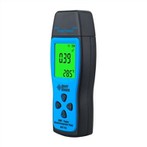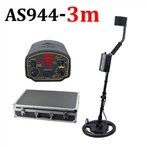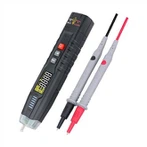How to Choose a Thermometer Correctly
Accuracy
Many resistance thermometers offer ppm, ohmic, and/or temperature specifications. The conversion from ohms or ppm to temperature depends on the thermometer used. For probes with a resistance of 100 Ω at 0 ° C, 0.001 Ω (1m Ω) is equal to 0.0025 ° C or 2.5mK. 1ppm is also equivalent to 0.1m Ω or 0.25mK. It is also necessary to pay attention to whether the technical indicators are "reading" or "range". For example, the "1ppm reading" is 0.1m Ω at 100 Ω, while the "1ppm range" is 0.4m Ω at a full scale of 400 Ω. The difference is very significant!
When checking accuracy technical indicators, it is important to remember that reading uncertainty has a minimal impact on the overall uncertainty of the calibration system, and purchasing a thermometer with the lowest uncertainty is not always economically meaningful. The analysis method of "bridge super resistance thermometer" is a good example. The cost of a 0.1-ppm bridge exceeds $40000, while the cost of a 1-ppm super resistance thermometer is less than $20000. Looking back at the overall system uncertainty, it is evident that the bridge can only improve performance to a small extent - in this case, it is 0.000006 ° C - at a very high cost.
measurement error
When conducting high-precision resistance measurements, it is necessary to ensure that the thermometer can eliminate the thermoelectric potential errors generated at different metal connections in the measurement system. A common technique for eliminating thermoelectric electromotive force errors is to use a switched DC or low-frequency AC current source.
resolving power
Be careful with this indicator. Some thermometer manufacturers confuse resolution and accuracy. A resolution of 0.001 ° C does not necessarily mean an accuracy of 0.001 ° C. Generally speaking, a thermometer with an accuracy of 0.001 ° C should have a resolution of at least 0.001 ° C. When detecting small temperature changes, display resolution is crucial - for example, when monitoring the solidification curve of a fixed point container or checking the stability of a calibration tank.
Linearity
Most thermometer manufacturers provide accuracy technical indicators at a temperature (usually 0 ° C). This is very useful, but you usually need to measure a wide temperature range, so it is important to understand the accuracy of the thermometer within the working range. If the linearity of the thermometer is very good, then its accuracy index is the same throughout its entire temperature range. However, all thermometers have a certain degree of nonlinearity and are not completely linear. Please ensure that the manufacturer provides accuracy technical indicators within the scope of work, or provide the linearity technical indicators you used when calculating uncertainty.
stability
Due to the need to measure over a wide range of environmental conditions and various time periods, reading stability is crucial. Ensure that the temperature coefficient and long-term stability indicators are checked. Ensure that changes in environmental conditions do not affect the accuracy of the thermometer. Reputable manufacturers provide temperature coefficient indicators. Long term stability indicators are sometimes combined with accuracy indicators - for example, "1ppm, 1 year" or "0.01 ° C, 90 days". It is difficult to calibrate every 90 days, so it is necessary to calculate the 1-year indicator and use it for uncertainty analysis. Beware of providers who provide '0 drift' metrics. Each thermometer will have at least one drift component.
calibration
Some thermometers require no recalibration according to technical specifications. However, according to the latest version of ISO guidelines, all measuring equipment needs to be calibrated. Some thermometers are easier to recalibrate than other devices. To use a thermometer that can be calibrated through its front panel without the need for special software. Some older thermometers store calibration data in EPROM memory and use custom software for programming. This means that the thermometer must be sent to the manufacturer for recalibration - perhaps overseas! Due to the time and cost involved in recalibration, it is important to avoid using thermometers that still use manual pressure gauges for adjustment. Most DC thermometers are calibrated using a set of highly stable DC standard resistors. Calibrating an AC thermometer or bridge is more complex, requiring a reference induction voltage divider and a precision AC standard resistor.
Traceability
Measuring traceability is another concept. The traceability of DC thermometers is very simple through good DC resistance standards. The traceability of AC thermometers and bridges is more complex. Many countries still do not have established traceability of AC resistance. Many other countries with traceable AC standards rely on AC resistors calibrated by thermometers or bridges with an uncertainty precision of ten times, which significantly increases the measurement uncertainty of the bridge itself.





